6. BioFabricating Materials¶
A collaborative works by Ruby Lennox, Maria-Rigina Chatzivalasi, Julija Karas, Hala Amer, and ChungHan Lu with mentorship from Petra and Julia.
| Bioplastic | a biobased polymer desived from a biomass. It is comprised of a biopolymer, plasticizer, and a solvent. |
| Polymer | assemblies of identical chemical subunits, called monomers, that are linked together in the form of a chain. |
| Biobased | Made of bacteria, fungi, mineral, vegetal, biosyntehtic, and animal. |
| Biodegradable | Degrades in specific conditions like pH sensitive environments, thermo sensitive, and enzymes. |
| Biocompostable | composted in 90 days like bacteria, mycelium, animals, etc. |
| Crafted | Casted, extruded, and/or assembled. |
| Grown | from scratch like fingii, microbial, and lab grown leathers. |
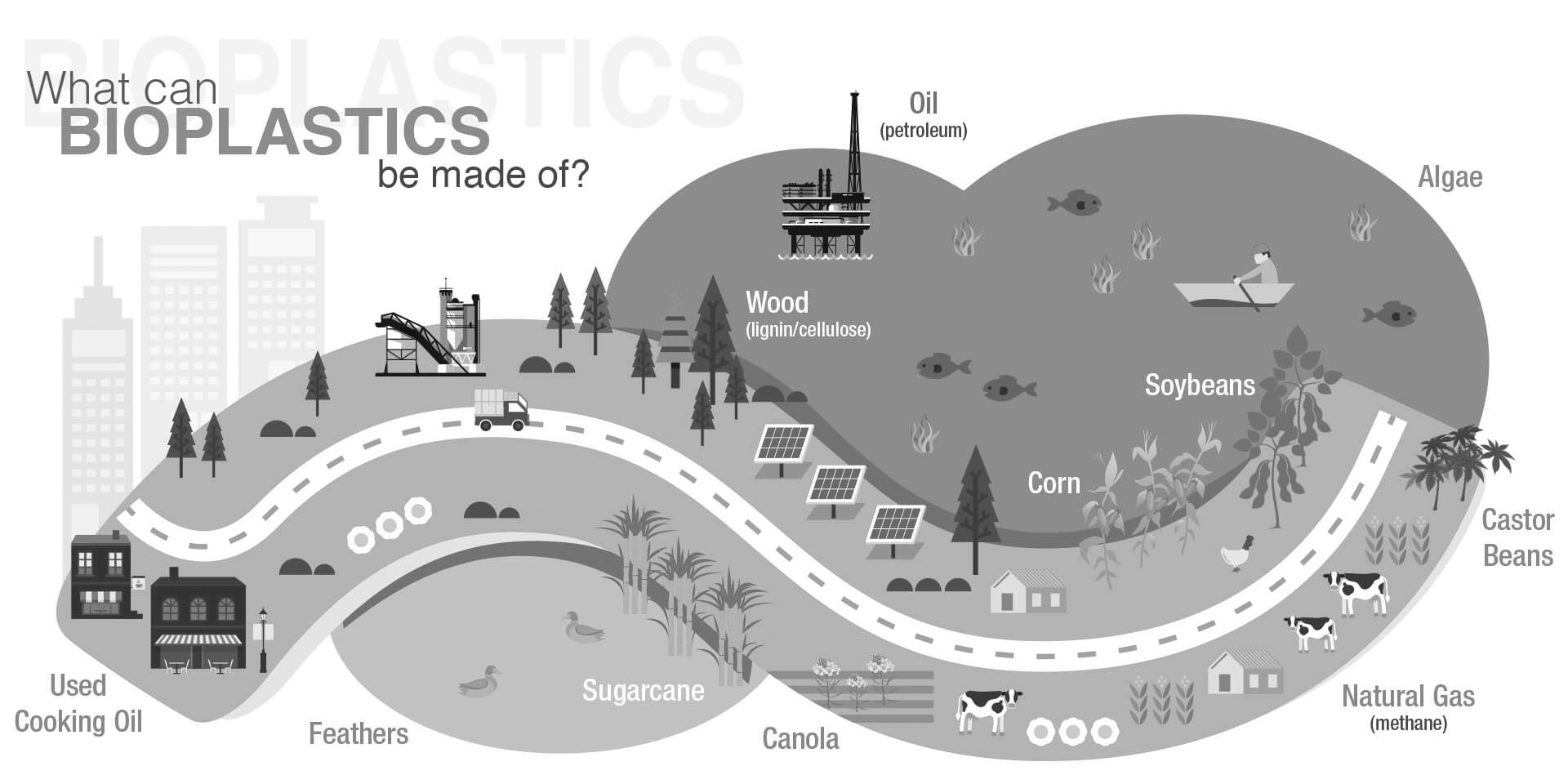
| Plastics | Bioplastics | |
| Polymer | Polymer | Alginate, gelatine, starch, etc |
| Plasticizer | to create flexibility | glycerine (the more glycerine the more elastic but never exceed the 1:1 ration) |
| Filler | to avoid shrinkage | any waste like egg shells, chalk, fibers, oils, etc |
| Stiffening | agent for structure and reinforcement | fibers and natural debri, roots, plant matter |
| Expanding | agent to create foams | green soaps and emulsifiers (waste water of canned chickpeas could be used) |
Plastics are usually made by mixing polymers with:
Biomaterials design properties are divided into structure, texture, color, and transparency.
You can make it magnetic by adding anything in the mixture that is magnet or magnetite. You can make it conductive by adding charcoal in it.
It matters what the sheets are casted on because it will adopt the textures and structures from the molds.
To play with the structural color of the cast, you can use defraction sheets.
Reference Projects¶
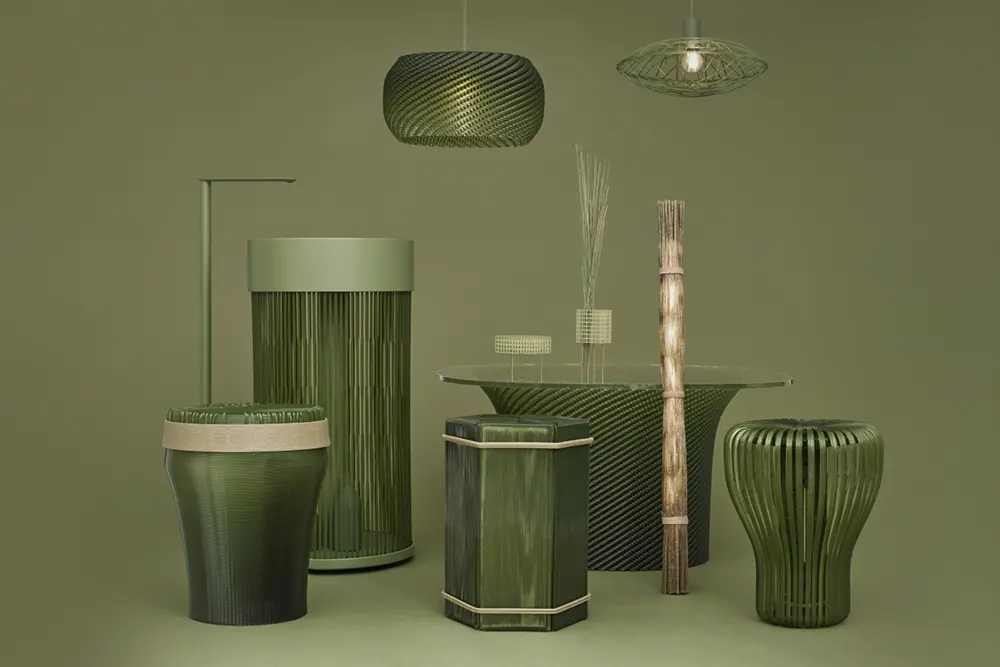 |
Tatami ReFAB | Repurposing and re-embeding tatami mats in modern life in Japan using 3D printing technology. |
 |
Algae Plastics | Using aquatic algae, drying them, and using them in material that can be 3D Printed. |
 |
Heterotopia | Screenprinting on lasercut carrot leather bag. |
Standard Recipes¶
Sodium Alginate¶
"The sodium salt from alginic acid and gum mainly extracted from the cell walls of brown algae. Brown seaweeds are usually larfe, and range from the giant kelp that is often 20m long, to thick, leather-like seaweeds from 2 - 4m long, to smaller species 30 - 60cm long." (Credit Material Archive TextileLab Amsterdam)
It is said that it is best to pour Sodium Alginate on woven textiles or on wood lasercut molds. In my personal experiments, I have poured it on cling film.
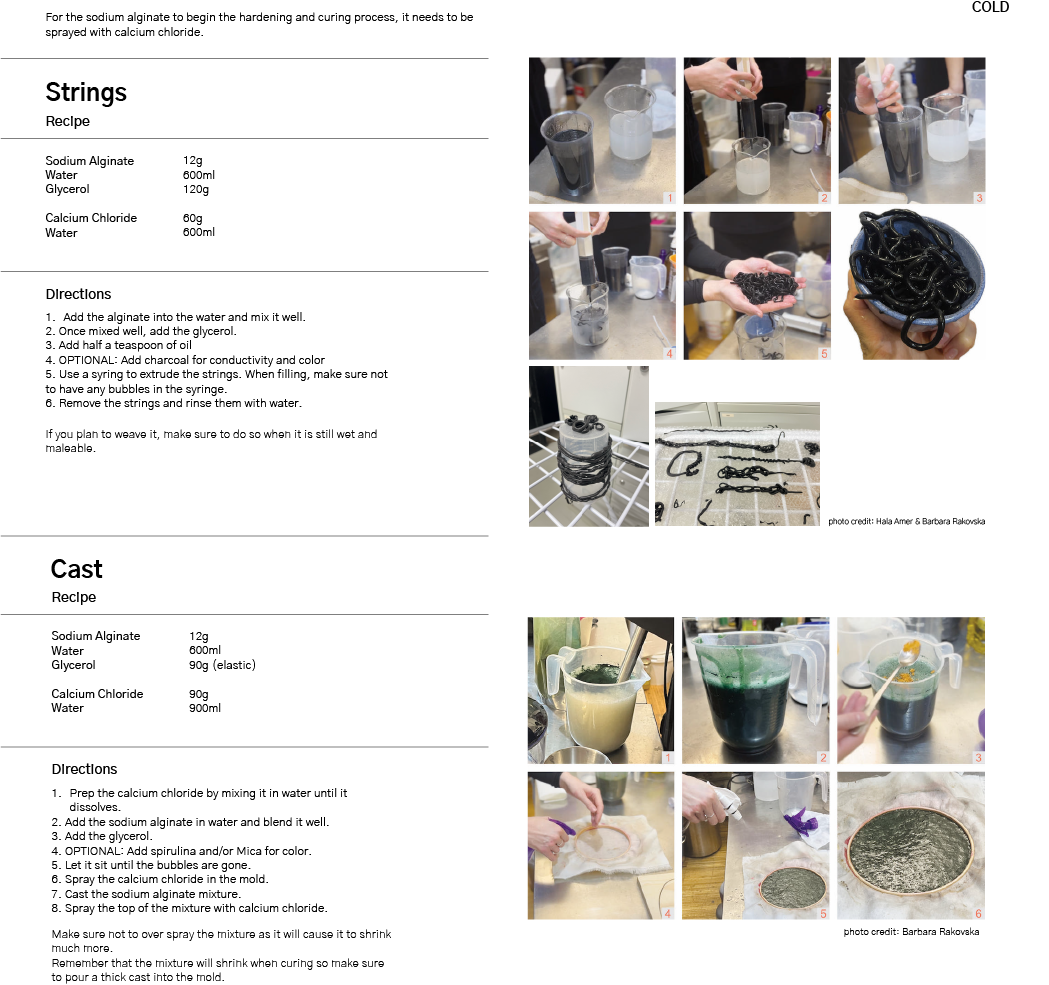
Alginate Recipes // Global Lecture
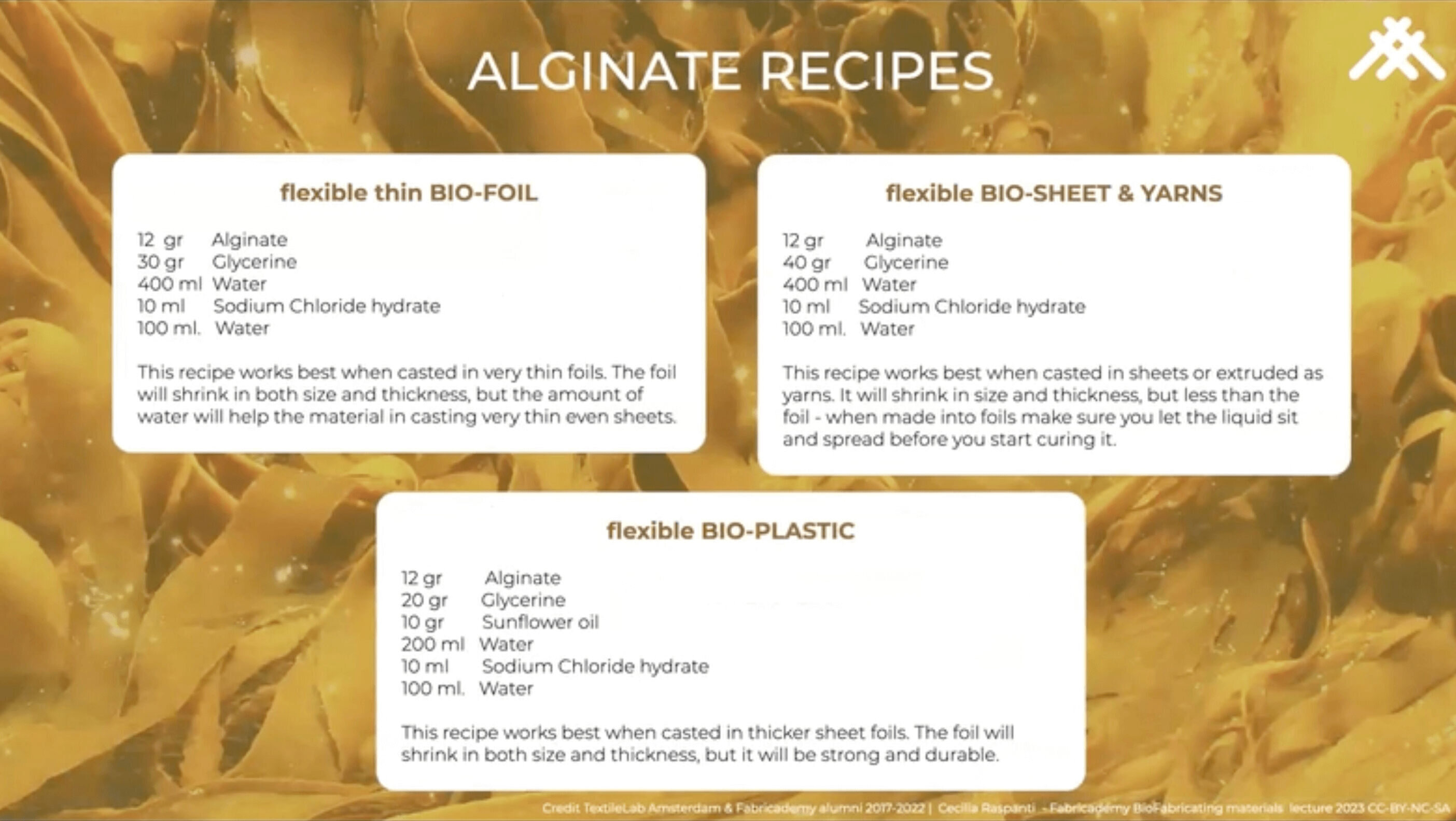
Top two recipes will remain transparent even with pigments and the bottom will become matte.
Special Characteristics¶
| Water Resistance | Sodium Alginate becomes water proof! Will only dissolve in alkaline water. |
| Heat Resistance | Withstands temperatures up to 150 degrees celsius. |
Gelatine¶
Animal derived ingredient made from collagen present in animal parts.
It is said that it is best to pour Gelatine mixtures on 3D printed molds. In my personal experiments, I have poured it on cling film.
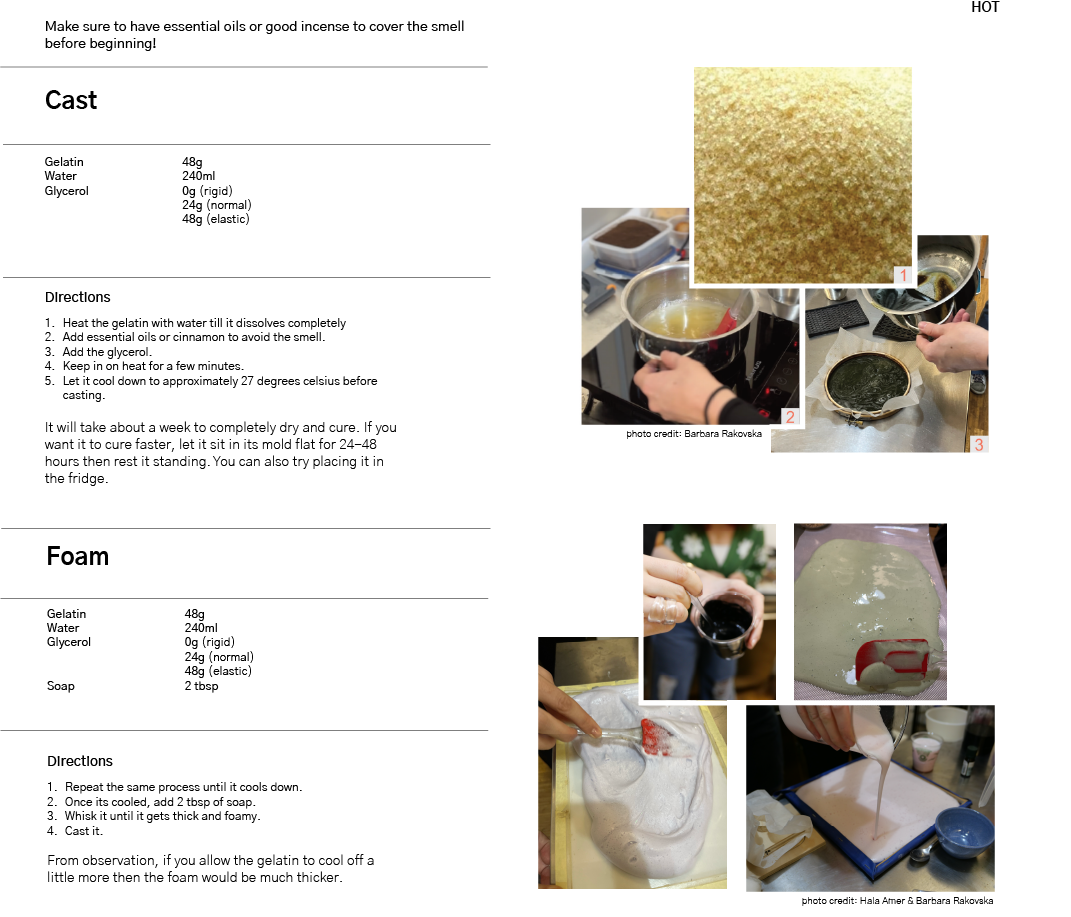
Gelatine Recipes // Global Lecture
Recasting gelatine that has already cured makes more stable materials.
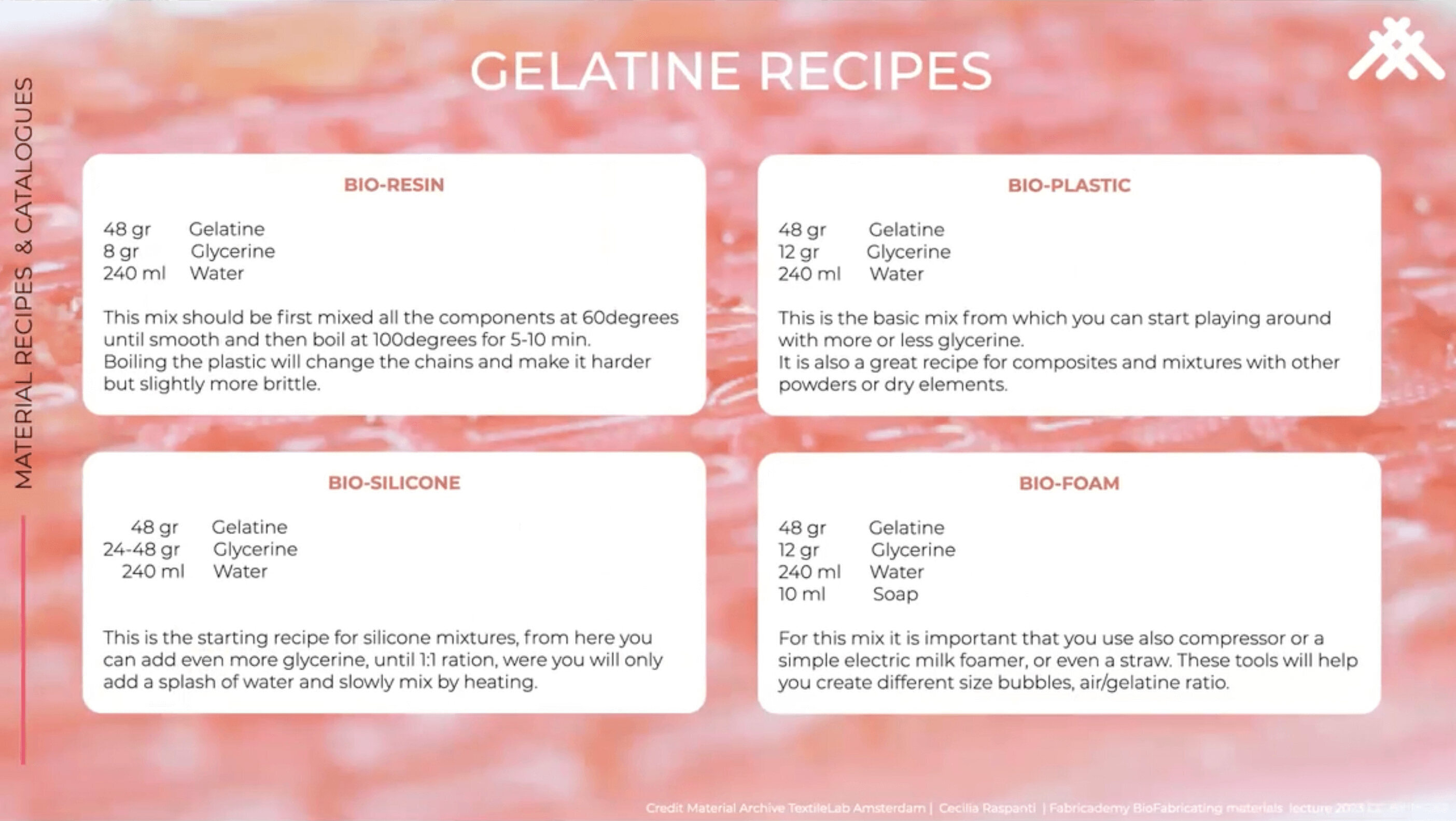
Special Characteristic:¶
| Water Resistance | Takes a couple of hours before dissolving in water. |
| Heat Resistance | Not heat resistant at all. Begins melting at 50 degrees celsius. |
Agar Agar¶
A jelly-like substance obtained from red algae. "Agar is a mixture of two components: the linear polysaccharide agarose, and a heterogenous mixture of smaller molecules called agaropectin. Agar is a compoind known as a polysaccharide." (Credit Material Archive TextileLab Amsterdam)
It is said that it is best to pour Agar Agar on woven textiles or on wood lasercut molds. In my personal experiments, I have poured it on cling film.
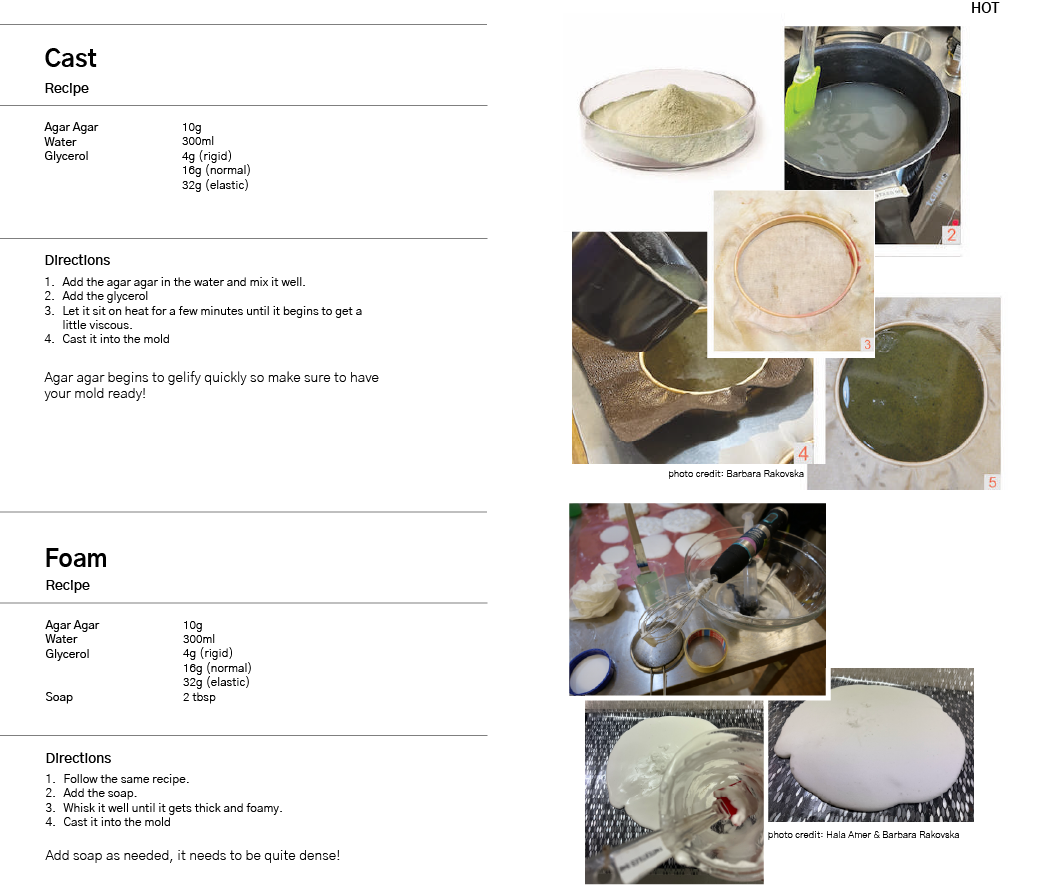
Agar Recipes // Global Lecture
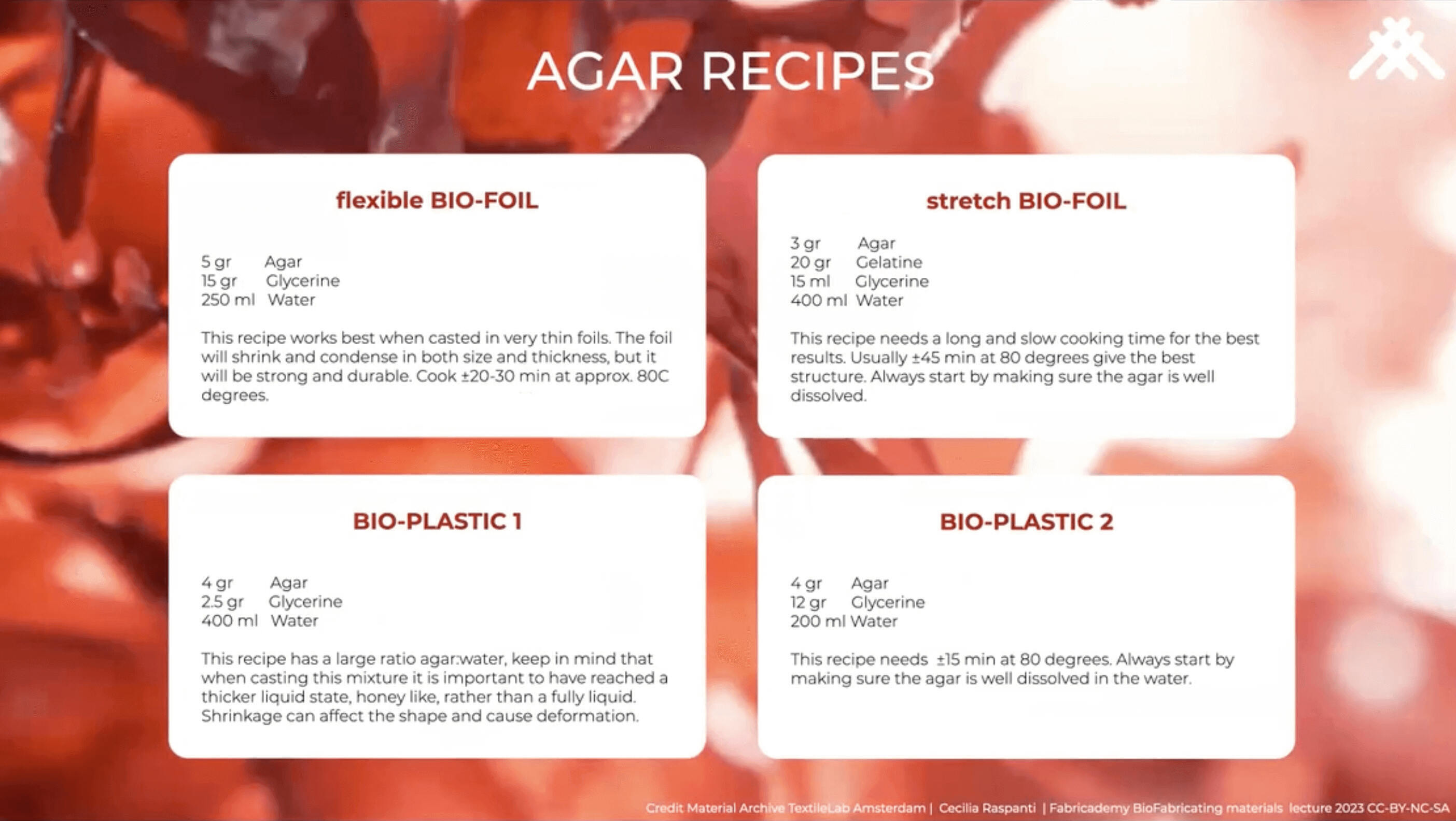
Some tips, Agar can be casted in very thin films, resembling plastic foils. It can never be elastic but it is flexible. (Credit Material Archive TextileLab Amsterdam)
Special Characteristic:¶
| Water Resistance | It dissolves in room temperature water in a few hours and hot water immediately. |
| Heat Resistance | Not heat resistant. Best for short term use. |
Resin¶
In our experiments, we have used pine resin with carnauba wax melted together and casted in wooden jigs to create the shapes. We also used fillers to check how that would change the resin's durability. Our experiment used sawdust as fillers.
Make sure to wear a mask when cooking the recipe as it produces a lot of fumes.

Leather¶
Carrot Leather
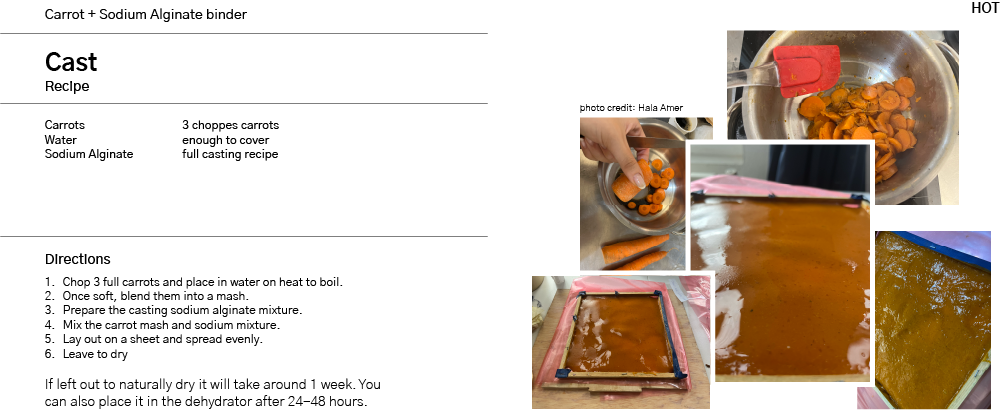
Banana Leather
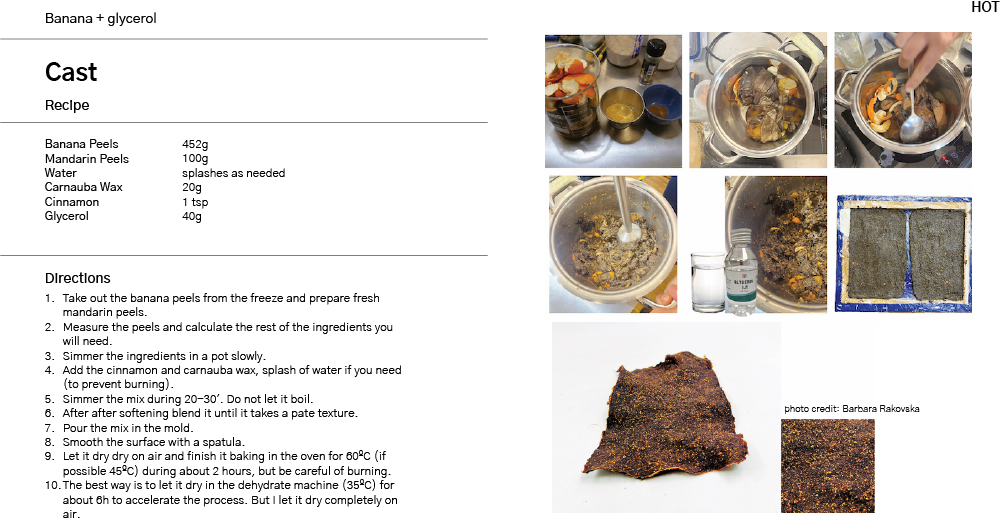
Mushroom Leather
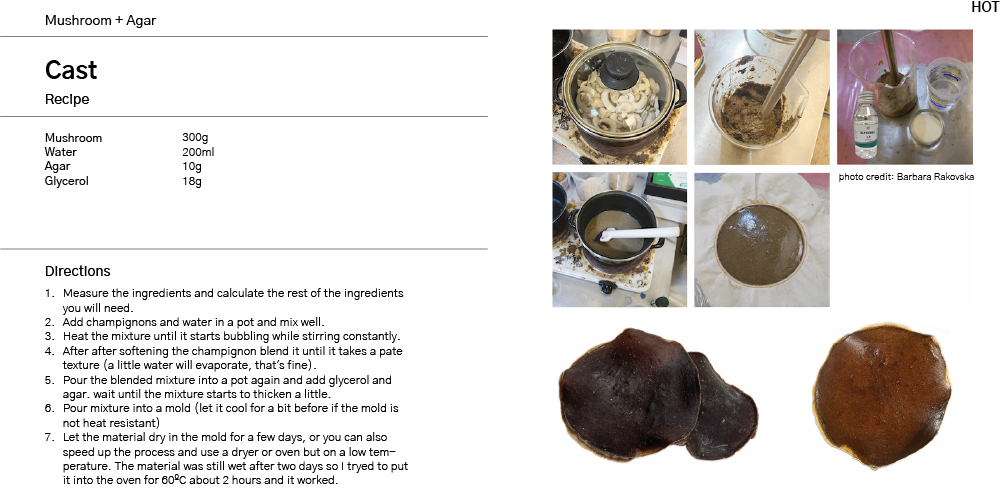
Mycelium¶
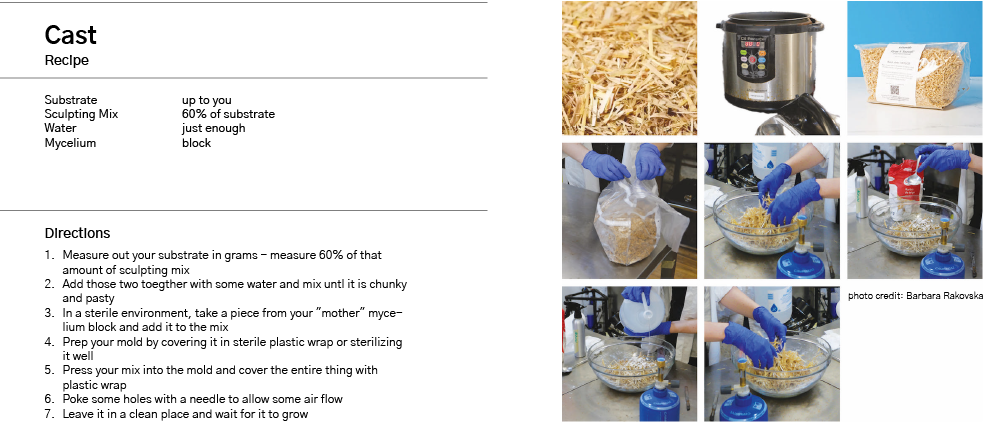
For the Grown Materials, we did a group test with some mycelium that we had at the Lab. We mixed it and pressed it into bowls as molds. Once done, we placed them in a locker for the darkness. Unfortunately, they were not super successful. Most of them got super moldy! Barbara's model was successful and can be seen on her page!
Overview material research outcomes¶
Agar Agar // Stretch Foil¶
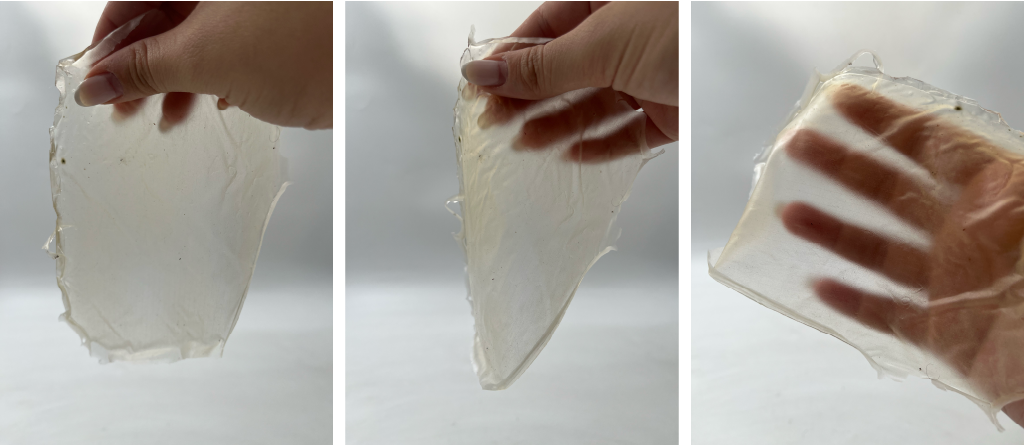 Using the stretch Bio-Foil recipe from the Global Lecture and pouring out a think layer.
Using the stretch Bio-Foil recipe from the Global Lecture and pouring out a think layer.
main experimenter: Hala Amer¶
Agar Agar // Flexible Foil¶
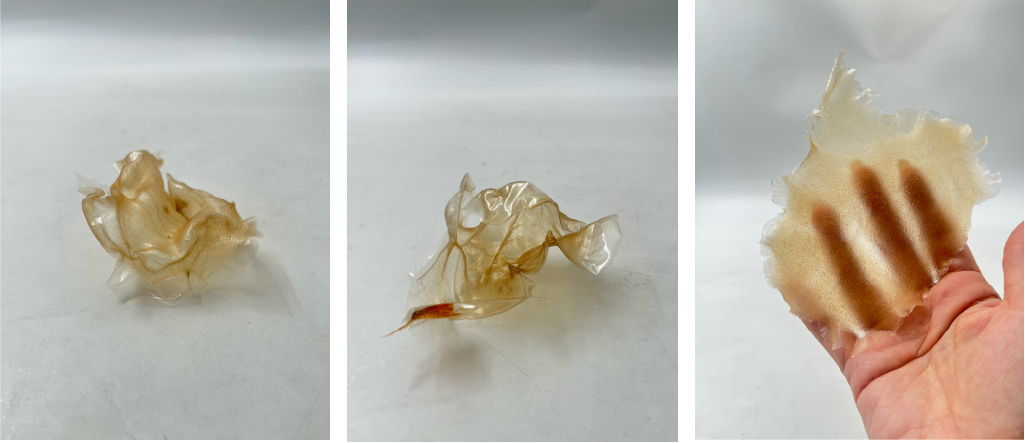 Using the flexible Bio-Foild recipe from the Global Lecture. Starting with no glycerol until 6g of glycerol (left to right).
Using the flexible Bio-Foild recipe from the Global Lecture. Starting with no glycerol until 6g of glycerol (left to right).
main experimenter: Hala Amer¶
Agar agar // Glycerol¶
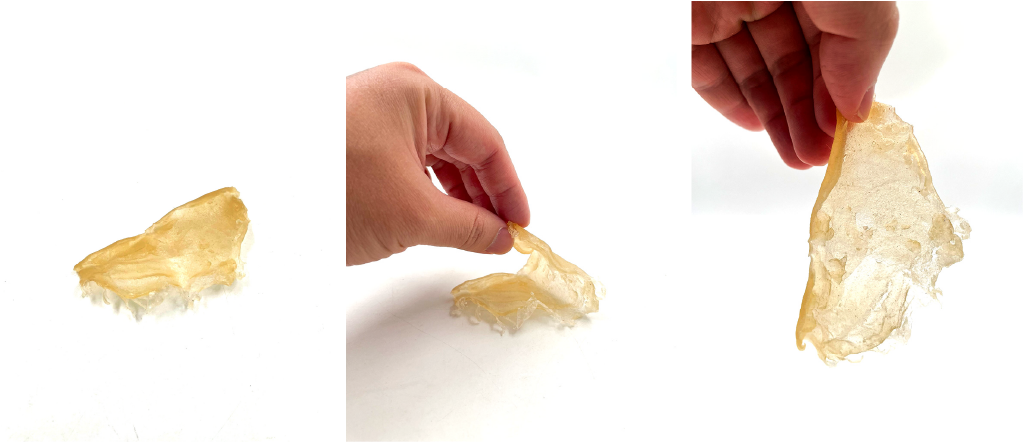 Based on recipe above, but in or to achieve "super elastic", add 48g Glycerol (initially elastic one 32g Glycerol), lay it on a flexible plastic sheet and try shaping it by rolling while it's partially dry.
Based on recipe above, but in or to achieve "super elastic", add 48g Glycerol (initially elastic one 32g Glycerol), lay it on a flexible plastic sheet and try shaping it by rolling while it's partially dry.
main experimenter: ChungHan Lu¶
Agar agar // Glycerol¶
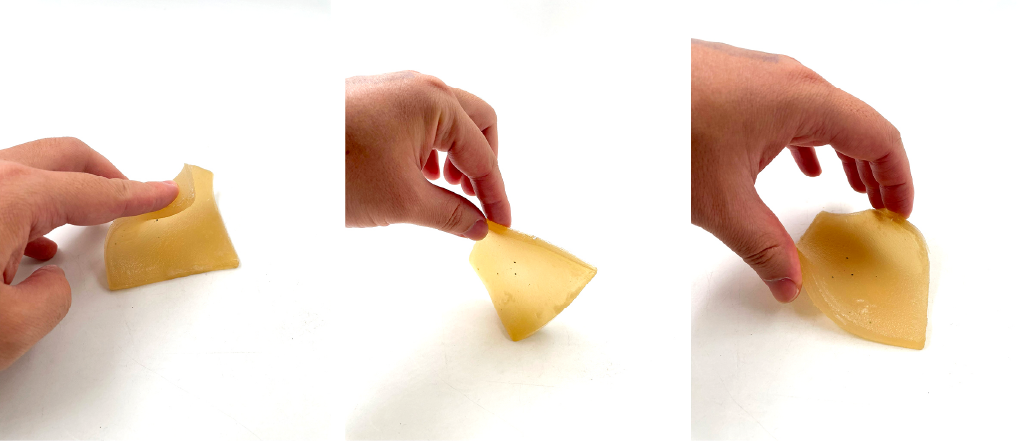 Based on recipe above, but in or to achieve "super elastic", added 48g Glycerol (initially elastic one 32g Glycerol), cast with the mold.
Based on recipe above, but in or to achieve "super elastic", added 48g Glycerol (initially elastic one 32g Glycerol), cast with the mold.
main experimenter: ChungHan Lu¶
Agar Agar // Sawdust // Pressed¶
 Recipe above for Agar Agar with sawdust added. Spread in even layer with circular moulds placed on top and pushed in for whole drying process.
Recipe above for Agar Agar with sawdust added. Spread in even layer with circular moulds placed on top and pushed in for whole drying process.
main experimenter: Ruby Lennox¶
Agar Agar // Eggshells¶
 Letting the agar become more viscous before adding the eggshells into the mixture. Puring it on a circular wooden surface and allowing it to dry on it.
Letting the agar become more viscous before adding the eggshells into the mixture. Puring it on a circular wooden surface and allowing it to dry on it.
main experimenter: Hala Amer¶
Agar Agar // Foam¶
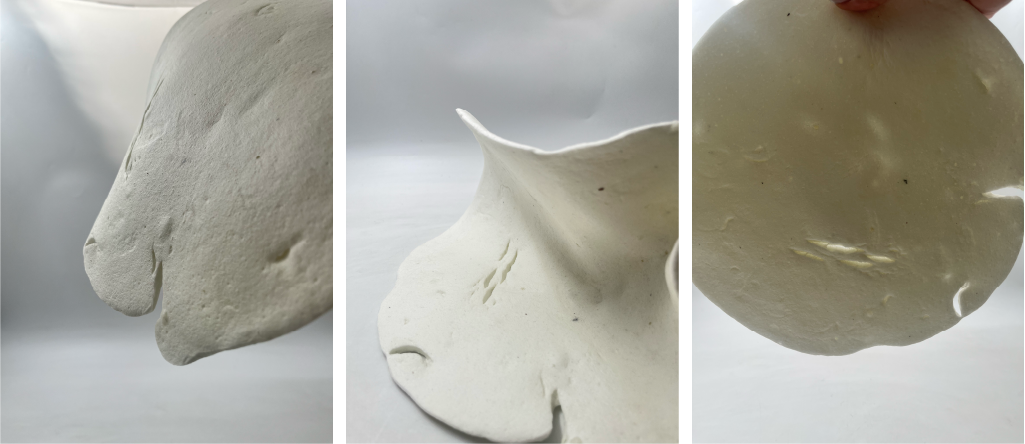 Whisking the regular agar recipe with soap to make a foam.
Whisking the regular agar recipe with soap to make a foam.
main experimenter: Hala Amer¶
Gelatin // Glycerol // Cabbage pigment¶
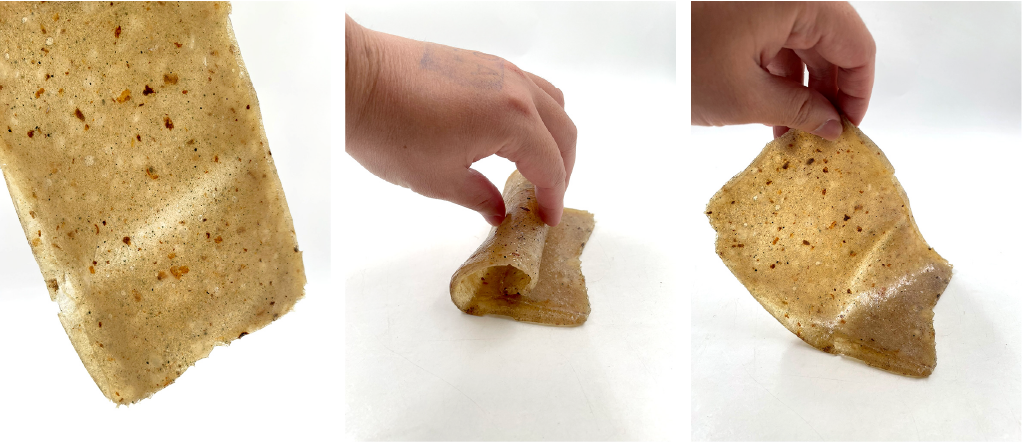 Recipe above(elstice one), added caggage pigment from Biochorme week. Unexpectedly, there were some burnt gelatin residues left at the bottom of the pot that got mixed into the new material during cooking. The dye's color isn't very pronounced, but these burnt gelatin substances added a new texture.
Recipe above(elstice one), added caggage pigment from Biochorme week. Unexpectedly, there were some burnt gelatin residues left at the bottom of the pot that got mixed into the new material during cooking. The dye's color isn't very pronounced, but these burnt gelatin substances added a new texture.
main experimenter: ChungHan Lu & Barbara Rakovská¶
Gelatin // Glycerol // Embedded Textile¶
 Recipe above(elstice one), try to combining different materials, hoping that the external textile would interact with the gelatin bioplastic. Pour in the mold like a "sandwich": starting with one layer of material, then placing the textile, and finally adding another layer of material.
Recipe above(elstice one), try to combining different materials, hoping that the external textile would interact with the gelatin bioplastic. Pour in the mold like a "sandwich": starting with one layer of material, then placing the textile, and finally adding another layer of material.
main experimenter: ChungHan Lu¶
Gelatin // Glycerol // Embedded Textile¶
 Recipe above(elstice one), was useing the textile as the main material(structure), gelatin bioplastic as a coating, resulting in a thin, transparent layer on the textile.
Recipe above(elstice one), was useing the textile as the main material(structure), gelatin bioplastic as a coating, resulting in a thin, transparent layer on the textile.
main experimenter: ChungHan Lu¶
Gelatine // Foam // Flexible // Dye Bath¶
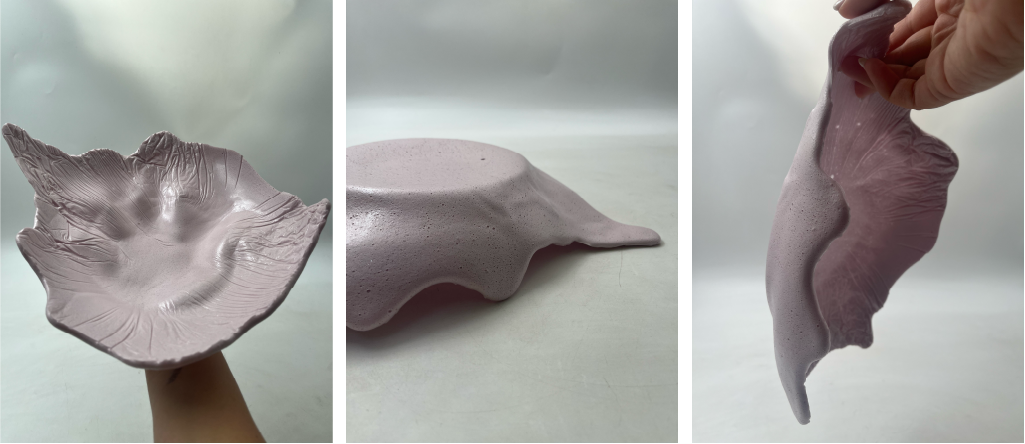 Using a dye bath instead of regular water and making a flexible gelatine mixture. Once cooled down, its whisked to create a foam.
Using a dye bath instead of regular water and making a flexible gelatine mixture. Once cooled down, its whisked to create a foam.
main experimenter: Hala Amer¶
Gelatine // Foam // Cabbage Dye Bath // Strings¶
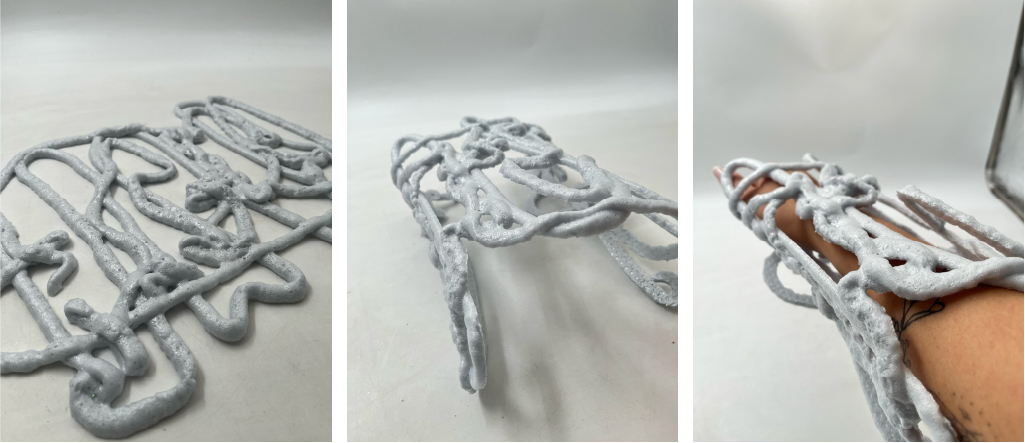 Using a dye bath instead of regular water and making a flexible gelatine mixture. Once cooled down, its whisked to create a foam.
Using a dye bath instead of regular water and making a flexible gelatine mixture. Once cooled down, its whisked to create a foam.
Using less Glycerol, 10g to 400ml of water.
Using a plastic bag, pouring it out strings in shapes.
main experimenter: Hala Amer¶
Gelatine // Foam // Cabbage Dye Bath¶
 Using a dye bath instead of regular water and making a flexible gelatine mixture. Once cooled down, its whisked to create a foam.
Using a dye bath instead of regular water and making a flexible gelatine mixture. Once cooled down, its whisked to create a foam.
Using less Glycerol, 10g to 400ml of water.
Pouring out a large blob. Resembles memory foam and goes back to shape in a few minutes.
main experimenter: Hala Amer¶
Gelatine // Foam // Rigid¶
 For the expansion of the biomass, soap is added to the mixture. This experiment was conducted to see how well gelatine can foam without any additives.
For the expansion of the biomass, soap is added to the mixture. This experiment was conducted to see how well gelatine can foam without any additives.
main experimenter: Julija Karas¶
Gelatine // Foam // Soap // Rigid¶
 Adding soap to the mixture creates a denser foam. The sample also bends while it is drying. That might have happened because no glycerol was added.
Adding soap to the mixture creates a denser foam. The sample also bends while it is drying. That might have happened because no glycerol was added.
main experimenter: Julija Karas¶
Gelatine // Foam // Soap // Soft // Glycerol¶
 Denser and softer sample as glycerol was added to the mixture.
Denser and softer sample as glycerol was added to the mixture.
main experimenter: Julija Karas¶
Gelatine // Foam // Soap // Soft // Glycerol¶
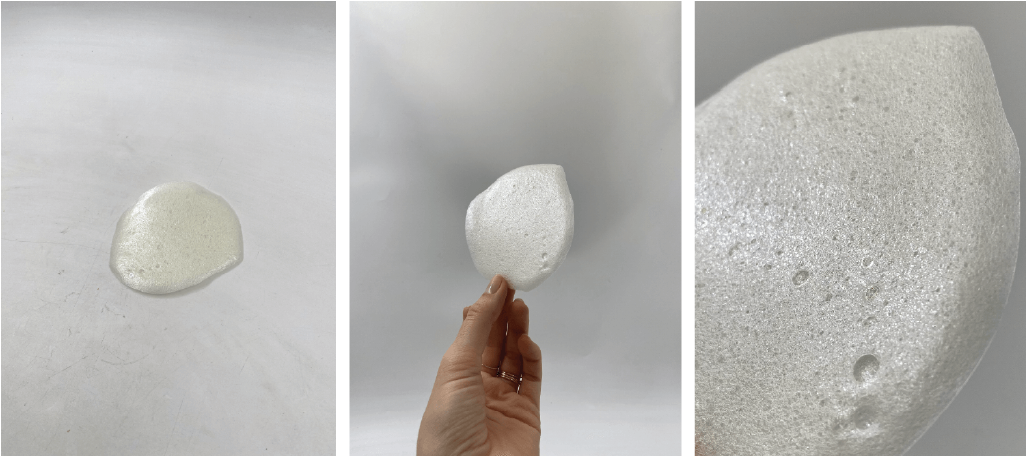 Whisking time of the biomass was longer which created an even denser and softer sample.
Whisking time of the biomass was longer which created an even denser and softer sample.
main experimenter: Julija Karas¶
Gelatine // Foam // Soap // Soft // Glycerol¶
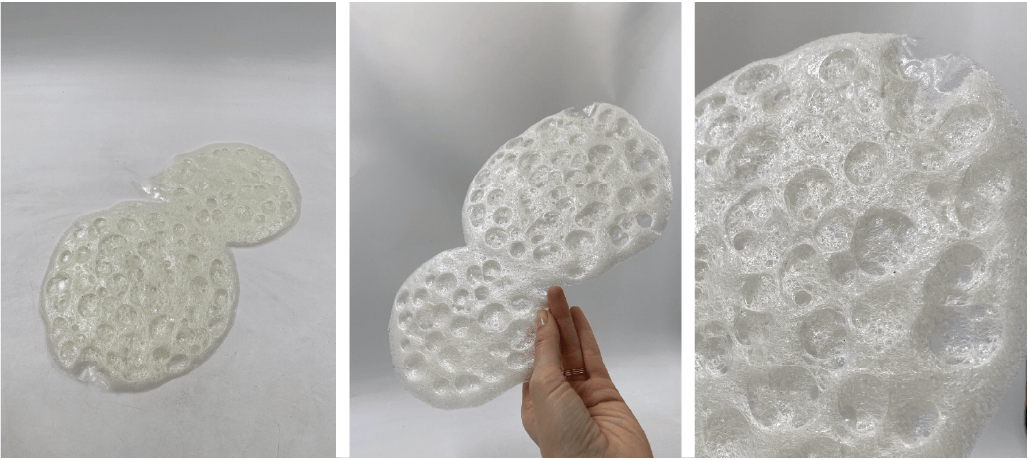 Air was injected into the mixture after whisking and casting.
Air was injected into the mixture after whisking and casting.
main experimenter: Julija Karas¶
Gelatine // Foam // Charcoal¶
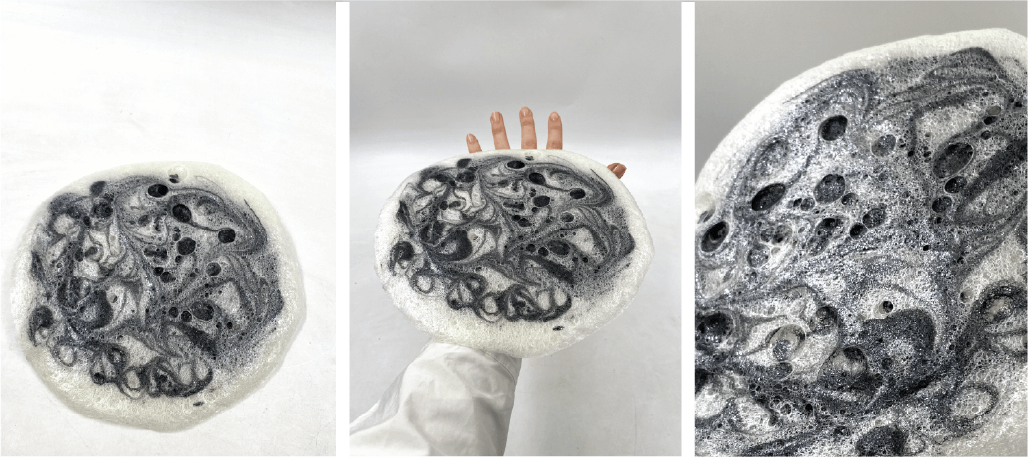 Sample using the regular recipe above with added charcoal. Charcoal was injected using a syringe to create the patterns and bubbles.
Sample using the regular recipe above with added charcoal. Charcoal was injected using a syringe to create the patterns and bubbles.
main experimenter: Julija Karas¶
Gelatine // Foam // Charcoal¶
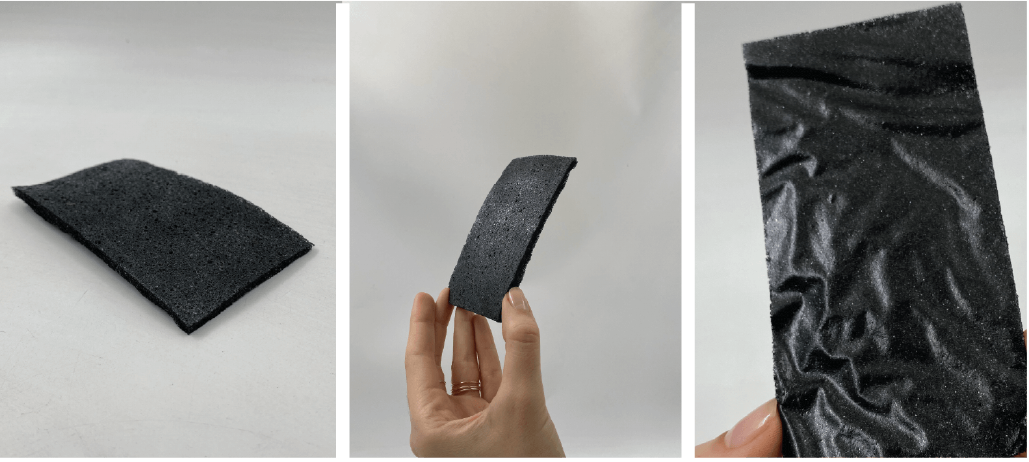 Lightweight rigid sample by casting it thin and not having glycerol.
Lightweight rigid sample by casting it thin and not having glycerol.
main experimenter: Julija Karas¶
Gelatine // Foam // Charcoal¶
 If a lot of charcoal is added to the mixture of biomass, the final material can be conductive. This was the first trial sample. Unfortunately, it is not conductive. Next step is to try with some metal powders instead.
If a lot of charcoal is added to the mixture of biomass, the final material can be conductive. This was the first trial sample. Unfortunately, it is not conductive. Next step is to try with some metal powders instead.
main experimenter: Julija Karas¶
Gelatine // Foam // Wool¶
 A sample mixing wool into the biofoam. An idea was to create a hard, thick, but light foam. Because of the thickness of the wet sample, the bottom side has not been able to dry properly and some of the wool fell out. No glycerol was added to the mix.
A sample mixing wool into the biofoam. An idea was to create a hard, thick, but light foam. Because of the thickness of the wet sample, the bottom side has not been able to dry properly and some of the wool fell out. No glycerol was added to the mix.
main experimenter: Julija Karas¶
Gelatine // Foam // Wool // Charcoal¶
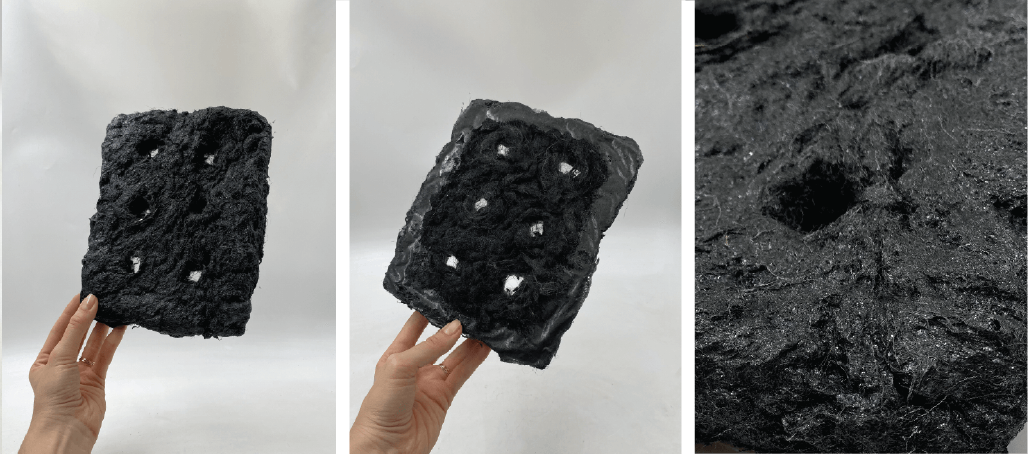 A biofoam wool brick. Experimenting with different types and consistencies of materials used: biofoam, wool, and charcoal.
A biofoam wool brick. Experimenting with different types and consistencies of materials used: biofoam, wool, and charcoal.
main experimenter: Julija Karas¶
Gelatine // Defraction¶
 Regular gelatine mixture casted on a degraction film sheet to test the color structure.
Regular gelatine mixture casted on a degraction film sheet to test the color structure.
main experimenter: Julija Karas¶
Alginate // Dye Bath // Woven¶
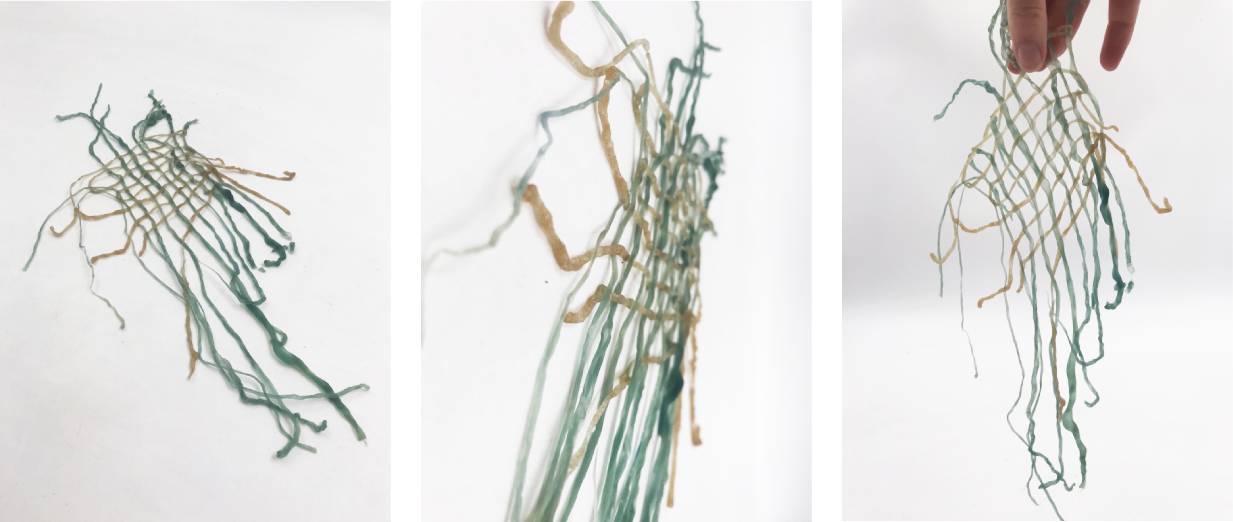 Recipe above for extruded alginate with dye bath from beetroot added for pink and from cabbage for blue strings. Woven while strings are wet.
Recipe above for extruded alginate with dye bath from beetroot added for pink and from cabbage for blue strings. Woven while strings are wet.
main experimenter: Ruby Lennox¶
Alginate // Dye Bath // Knit¶
 Recipe above for extruded alginate with dye bath from beetroot added. Knit while wet.
Recipe above for extruded alginate with dye bath from beetroot added. Knit while wet.
main experimenter: Ruby Lennox¶
Alginate // Charcoal // Knit¶
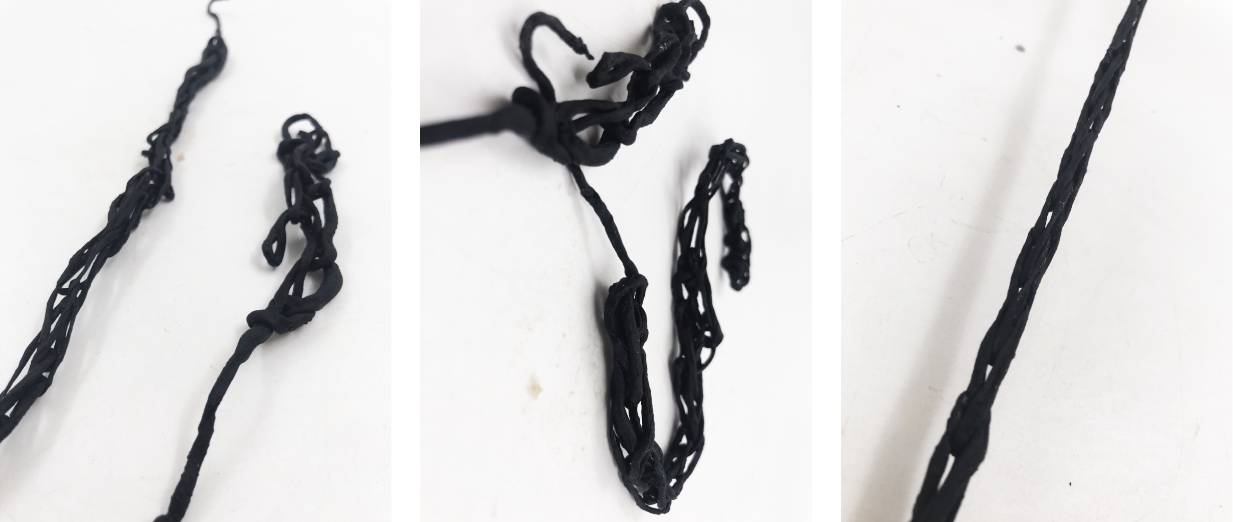 Recipe above for extruded alginate with charcoal added. Knit into chain while wet.
Recipe above for extruded alginate with charcoal added. Knit into chain while wet.
main experimenter: Ruby Lennox¶
Alginate // Sawdust¶
 Recipe above for alginate mixed about 10:8 alginate to sawdust. Moulded around a glass while wet.
Recipe above for alginate mixed about 10:8 alginate to sawdust. Moulded around a glass while wet.
main experimenter: Ruby Lennox¶
Alginate // Sawdust // Layering¶
 Recipe above for alginate. Layers or alginate in different shapes covered in sawdust between each layer then sprayed with calcium chloride.
Recipe above for alginate. Layers or alginate in different shapes covered in sawdust between each layer then sprayed with calcium chloride.
main experimenter: Ruby Lennox¶
Alginate // Molded¶
 Recipe above for alginate painted in a very thin layer then sprayed with calcium chloride and reshaped while gelling.
Recipe above for alginate painted in a very thin layer then sprayed with calcium chloride and reshaped while gelling.
main experimenter: Ruby Lennox¶
Alginate // Layering¶
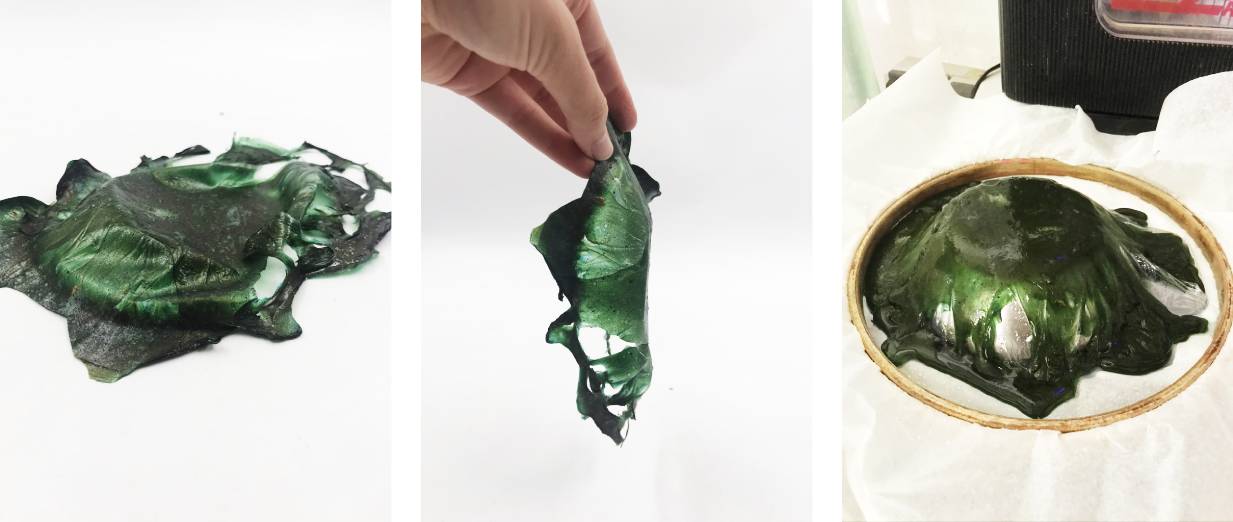 Recipe above for alginate. Multiple layers poured over a bowl mould with calcium chloride spared in between each layer.
Recipe above for alginate. Multiple layers poured over a bowl mould with calcium chloride spared in between each layer.
main experimenter: Ruby Lennox¶
Alginate // Foam // Charcoal¶
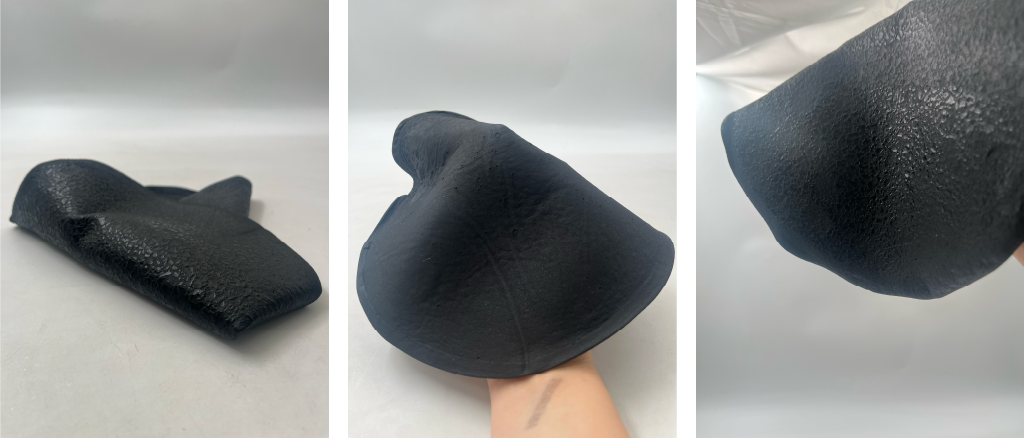 Adding charcoal to the sodium alginate mixture. After allowing it to cool, whisking it to make foam.
Adding charcoal to the sodium alginate mixture. After allowing it to cool, whisking it to make foam.
main experimenter: Hala Amer & Julija Karas¶
Alginate // Foam // Spirulina¶
 Adding spirulina to the sodium alginate mixture. After allowing it to cool, whisking it to make foam. Once casted, a lasercut pattern is placed on top to get the shape.
Adding spirulina to the sodium alginate mixture. After allowing it to cool, whisking it to make foam. Once casted, a lasercut pattern is placed on top to get the shape.
main experimenter: Hala Amer & Julija Karas¶
Leather // Carrot // Sodium Alginate¶
 Recipe above. Chopped carrots with sodium alginate mixture with glycerol for flexibility.
Recipe above. Chopped carrots with sodium alginate mixture with glycerol for flexibility.
main experimenter: Hala Amer¶
Pine resin // Carnauba wax // Alcohol // Saw dust¶
 Recipe above, but would like to keep more translucency, so added less filler.
Recipe above, but would like to keep more translucency, so added less filler.
main experimenter: all¶
Potential Research¶
Date Palm Trees.
As this is my first time reading about biomaterials and working with them I happened to notice the use of Oil Palm and was intrigues in whether the Date Palm Tree has been experimented with. I found a number of scientific research papers stating that the Date Palm Tree has lots of potential to be used and has a lot of waste in the life cycle of the tree.
Date Palm Tree Waste Recycling: Treatment and Processing for Potential Engineering Applications
"It takes around six years for date palms to bear fruit after planting and around nine years to produce viable yields for commercial harvest. Usually, date palm wastes are burned on farms or disposed in landfills, which cause environmental pollution in date-producing nations. In addition, date palm has a high volatile solid content and low moisture content. These factors make date palm residues an excellent biomass resource in date-palm producing nations."

"The offshoot should be removed, and dead or defective fronds need to be removed yearly, which generates about 20 kg of waste per year from only one date palm. Some studies have reported that Saudi Arabia alone generates more than 200,000 tons of date palm biomass each year. The date palm wastes are in the form of fronds, offshoots, dried fronds base (karab), and date pits. According to local farmers, they usually collect this waste and burn it. A small fraction of the waste is shredded and blended with other bio waste to be used as animal feed, or leaved aside to break down naturally to be used as fertilizer."

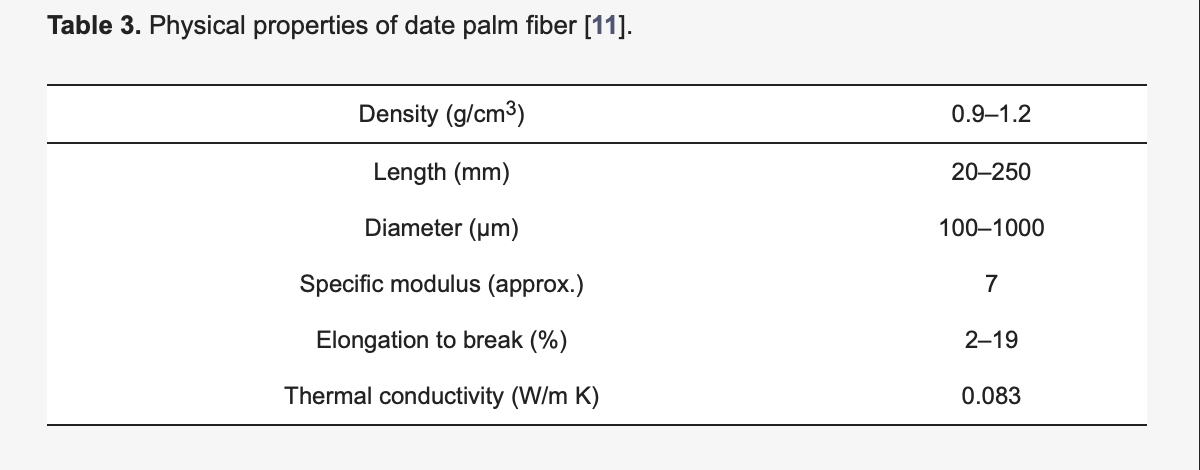
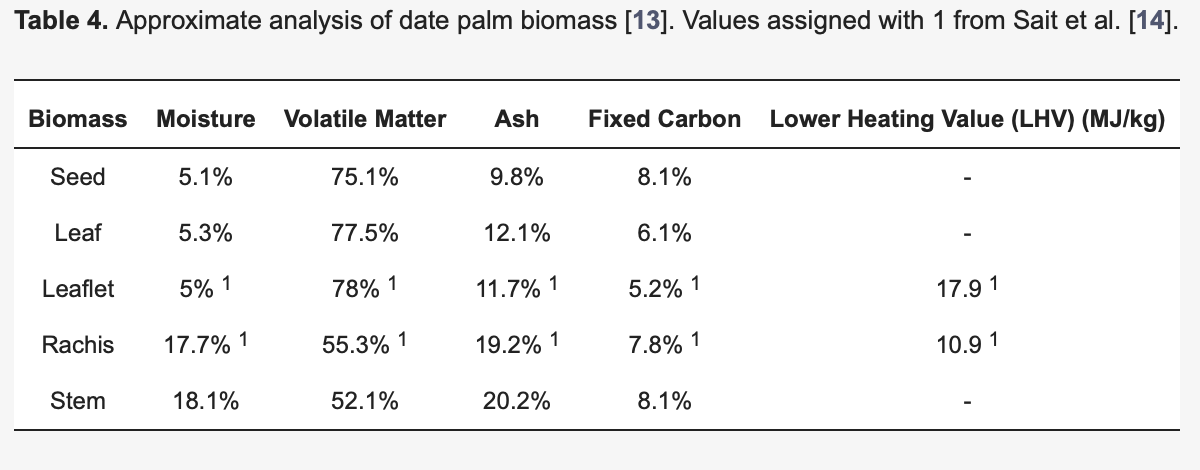

"However, the improper handling of underutilized date palm bunch stalk after harvest season has resulted in the biomass waste disposal problem. Generally, the bunch stalk part of date palm contains 44.0 % cellulose, 26.0 % hemicellulose, and 11.5 % lignin, and the rest of 18.5 % other compounds. Therefore, the environmental concern can be reduced by deriving its cellulose-riched date palm bunch stalk into nanocellulose product.
Celllose nanocrystal (CNC), a nano-sized particle from plant biomass, is a promising bio-filling agent that often used in polymer reinforcement application. From the aspect of feature, CNC is a rod-like elementary crystals with its intact crystalline feature.
Effects of Replacing Cement by Date Palm Trees Wastes on Concrete Performance
"The results showed that palm leaves ash enhanced concrete workability and concrete compressive strength."
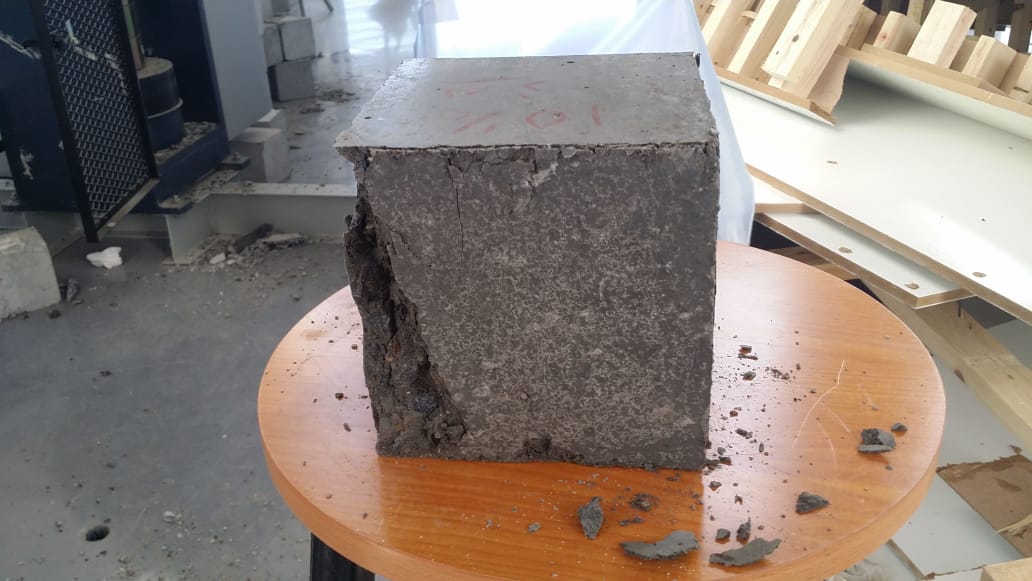
Ecofriendly Dyeing of Textile Materials with Natural Colorants from Date Palm Fiber Fibrillium
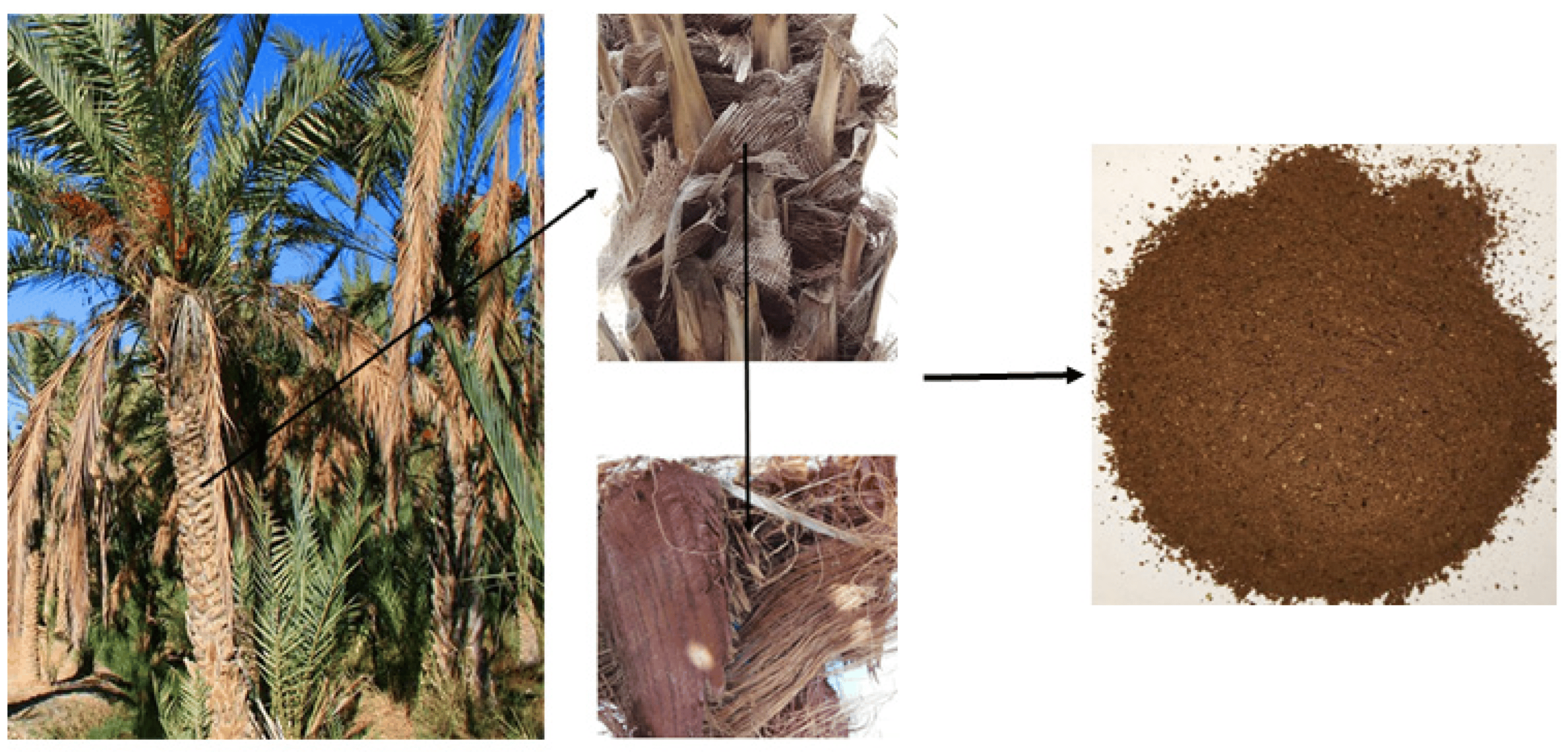
"The fibrillium material was collected in December 2021 in the Gabes region, a city in southeastern Tunisia with an oasis of hundreds of thousands of palm trees. Samples are finely chopped to remove decomposed parts and washed with water to remove dirt and dust. They were then dried and finely ground into a powder. A multi-fiber fabric consisting of different fibers and containing fabric strips (acetate, cotton, nylon, polyester, acrylic, and wool) was used for testing affinity. 100% washed and bleached wool fabrics (200 g/m2) and bleached polyamide knit fabrics (150 g/m2) have been used to investigate the overall dyeing parameters. Alum, ferrous sulfate and tannic acid were laboratory reagents grade and were used without further purification. Commercial Mimosa extract was obtained from Silvateam. In the current study, 50 g of ground date palm plant was boiled for 1 h in 1 L of distilled water. The resulting solution was then filtered to remove plant debris and used for dyeing."
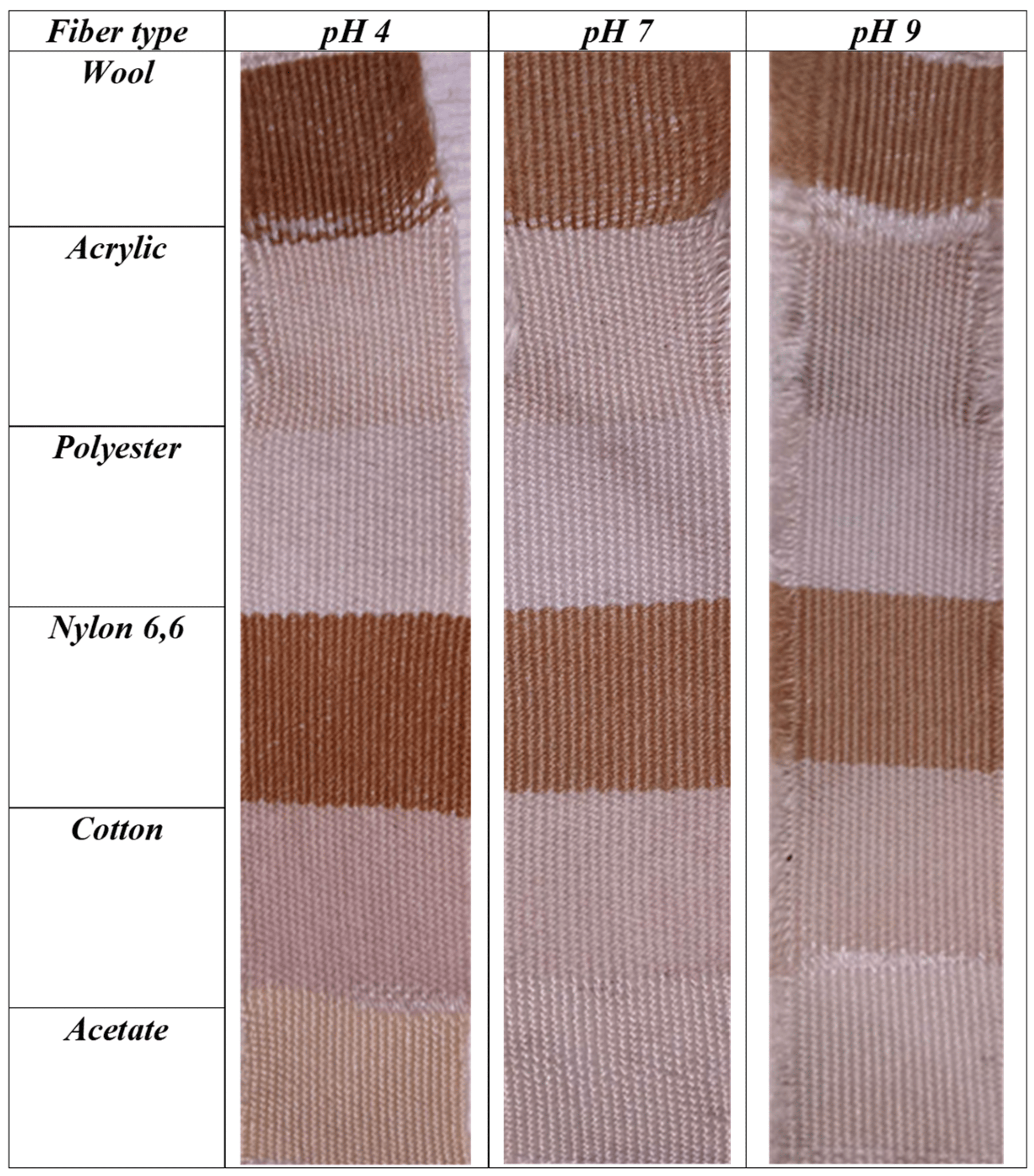
As of now, I have not been able to collect any fibers to carry out the experiments. I hope to be able to do so when I'm back home and add it then!